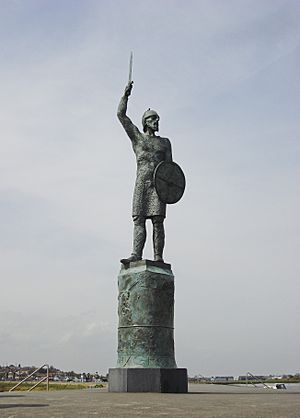Byrhtnoth facts for kids

Byrhtnoth (Old English: Byrhtnoð) was an important leader, known as an Ealdorman, in Essex during the Anglo-Saxon period. He lived from about 931 until August 11, 991. Byrhtnoth is famous for his death at the Battle of Maldon. His name comes from Old English words meaning "bright" and "courage."
Byrhtnoth is a key figure in the old poem The Battle of Maldon. He also appears in a play by J.R.R. Tolkien called The Homecoming of Beorhtnoth, Beorhthelm's Son. Today, you can see a statue of him in Maldon, Essex.
Contents
Byrhtnoth's Last Battle
Byrhtnoth died while leading the Anglo-Saxon army against Viking invaders in 991. This event is the main topic of the famous Old English poem The Battle of Maldon. The poem describes his decision to let the Vikings move to a better fighting spot. This choice was seen as brave, but it led to his death.
Byrhtnoth was a tall man, over six feet, and about sixty years old at the time of the battle. He had "swan-white hair." It is believed he fell early in the fight. Some stories say it took three men to kill him. One of them almost cut off his arm. Before this battle, Byrhtnoth had won several military victories. These were likely also against Viking raiders.
Helping the Church and His Burial
Byrhtnoth was a strong supporter of Ely Abbey, which was a large church at the time. He gave the Abbey many villages. These included Spaldwick, Trumpington, Rettendon, Soham, Fulbourn, Impington, Pampisford, and Teversham.
He was buried at Ely Abbey. His grave was next to Archbishop Wulfstan. The Liber Eliensis, a book from Ely, says his wife gave the Abbey a special cloth or tapestry. This tapestry showed his brave deeds. It was probably like the famous Bayeux Tapestry. She gave it right after his death, so it might have been in their home before.
Moving Byrhtnoth's Remains
After his first burial, Byrhtnoth's remains were moved three times. His bones, along with six other important Saxon church supporters, were reburied. These seven people were known as the 'Confessors of Christ'.
Around the mid-1150s, their remains were moved to the new Norman church. This church later became Ely Cathedral. In 1322, part of the cathedral collapsed. A new area was built, and the seven benefactors were buried within a wall there. Paintings of them were put on the wall. This was probably to remind visitors of their generosity.
Later, in 1769, the wall was taken down. James Bentham found the remains of the seven benefactors. Each was in a separate section. Byrhtnoth's bones were found, but his skull was missing. His bones showed he was very tall, about 6 feet 9 inches. On July 31, 1781, they were buried again. This time, they were placed in special spots in Bishop Nicholas West's Chantry chapel.
Byrhtnoth's Family
Byrhtnoth was married to a woman named Ælfflæd. She was the sister of Queen Æthelflæd of Damerham. This meant Byrhtnoth was related to King Edgar through marriage.
Byrhtnoth and Ælfflæd had a daughter. She married a man named Oswig. Oswig died in the Battle of Ringmere in 1010. Some records also mention a daughter named Leofflæd. It is likely that Leofflæd was the same daughter who married Oswig.
Byrhtnoth's Lasting Impact
In October 2006, a statue of Byrhtnoth was placed in Maldon. It was created by John Doubleday. The statue faces Northey Island and the Causeway, where the battle took place. The battle site itself has a National Trust plaque. It remembers Byrhtnoth's "heroic defeat and death."
Besides the Old English poem, The Battle of Maldon, J.R.R. Tolkien also wrote about Byrhtnoth. His short play, The Homecoming of Beorhtnoth, Beorhthelm's Son, is set on the Maldon battlefield. It tells the story of searching for Byrhtnoth's body.
In 2015, Timebomb Comics released a graphic novel. It is called 'Defiant! The Legend of Brithnoth'. This book tells the story of Byrhtnoth and the Battle of Maldon in a comic book style.
See also
- The Homecoming of Beorhtnoth Beorhthelm's Son

